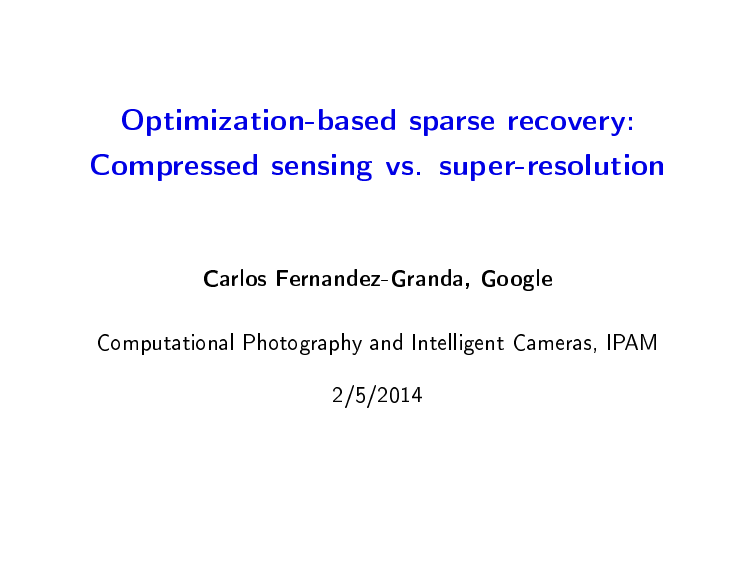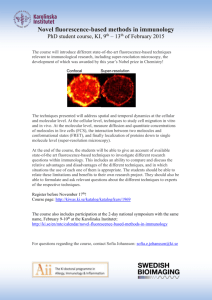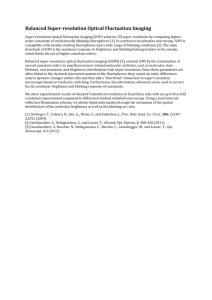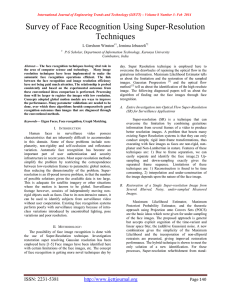Optimization-based sparse recovery: Compressed sensing vs. super-resolution Carlos Fernandez-Granda, Google
advertisement

Optimization-based sparse recovery:
Compressed sensing vs. super-resolution
Carlos Fernandez-Granda, Google
Computational Photography and Intelligent Cameras, IPAM
2/5/2014
I
I
This work was supported by a Fundación La Caixa Fellowship and a
Fundación Caja Madrid Fellowship
Joint work with Emmanuel Candès (Stanford)
Optimization-based recovery
Optimization
Object
Sensing system
Data
Outline
Two inverse problems
When is the problem well posed?
When do optimization-based methods succeed?
Two inverse problems
When is the problem well posed?
When do optimization-based methods succeed?
Compressed sensing
Object
Data
Compressible
Randomized
Mathematical model: Random Fourier coecients of sparse signal
Super-resolution
Object
Data
Point sources
Low-pass blur
Mathematical model: Low-pass Fourier coecients of sparse signal
(Figures courtesy of V. Morgenshtern)
Motivation: Limits of resolution in imaging
The resolving power of lenses, however perfect, is limited
(Lord Rayleigh)
Diraction imposes a fundamental limit on the resolution of optical systems
Super-resolution
Spectrum
Object
Data
Super-resolution
I
I
I
Optics: Data-acquisition techniques to overcome the diraction limit
Image processing: Methods to upsample images onto a ner grid
while preserving edges and hallucinating textures
This talk: Estimation/deconvolution from low-pass measurements
Compressed sensing
Super-resolution
Spectrum interpolation
Spectrum extrapolation
Two inverse problems
When is the problem well posed?
When do optimization-based methods succeed?
Compressed sensing
x
...
Spectrum
of x
=
...
Fourier series of a measure/function x with domain [0, 1]
Compressed sensing
x
=
Spectrum
of x
Discrete Fourier transform (DFT) of a vector x ∈ RN
Compressed sensing
x
=
Data: Random DFT coecients
Spectrum
of x
Compressed sensing
=
x
Data: Random DFT coecients
Compressed sensing
=
x
What is the eect of the measurement operator on sparse vectors?
Compressed sensing
=
x
Crucial insight: restricted operator is well conditioned when acting upon
any sparse signal (restricted isometry property) [Candès, Tao 2006]
Compressed sensing
=
x
Crucial insight: restricted operator is well conditioned when acting upon
any sparse signal (restricted isometry property) [Candès, Tao 2006]
Super-resolution
I
Signal: superposition of spikes (Dirac measures) in the unit interval
x
I
=
X
j
a
j ∈ C, tj ∈ [0, 1]
j δt
a
j
Data: low-pass Fourier coecients with cut-o frequency fc
Z
( )=
y k
0
1
e
−i 2π kt
x
(dt ) =
X
j
j
a e
−i 2π ktj
,
k
∈ Z, |k | ≤ fc
Super-resolution
x
...
Spectrum
of x
=
...
Fourier series of a measure x with domain [0, 1]
Super-resolution
y
x
...
=
...
Data: Low-pass Fourier coecients
Super-resolution
=
y
x
Data: Low-pass Fourier coecients
Super-resolution
=
y
x
Problem: If the support is clustered, the problem may be ill posed
In super-resolution sparsity is not enough!
Super-resolution
=
y
x
If the support is spread out, there is still hope
We need conditions beyond sparsity
Minimum separation
The minimum separation ∆ of the support of x is
∆=
inf
(t ,t 0 ) ∈ support(x ) : t 6=t 0
|t − t 0 |
Conditioning of submatrix with respect to ∆
If ∆ < λc := 1/fc the problem is ill posed
λc is the diameter of the main lobe of the point-spread function
(twice the Rayleigh distance)
Example: 25 spikes,
fc
= 103 , ∆ = 0.8/fc
Signals
Data (in signal space)
0.3
300
0.2
200
0.1
0
100
0
0.3
300
0.2
200
0.1
0
100
0
Example: 25 spikes,
0.3
fc
= 103 , ∆ = 0.8/fc
Signal 1
Signal 2
300
Signal 1
Signal 2
0.2
200
0.1
100
0
0
Signals
Data (in signal space)
Example: 25 spikes,
fc
= 103 , ∆ = 0.8/fc
The dierence is almost in the null space of the measurement operator
100
0.2
10−2
10−4
0
10−6
−0.2
10−8
−2,000 −1,000
Dierence
0
Spectrum
1,000
2,000
Two inverse problems
When is the problem well posed?
When do optimization-based methods succeed?
Estimation via convex programming
Measurement model: Underdetermined linear system
(we need further assumptions)
Ax
≈y
Idea: Impose nonparametric assumptions on structure by
minimizing a cost function
min
x̃
C (x̃ )
subject to
In our case: `1 norm to enforce sparsity
Ax̃
= y,
Subgradients
Denition: gx is a subgradient of a convex function C at x if for
any vector v
C (x + v ) ≥ C (x ) + hgx , v i
Lemma
If there is a subgradient of C at x in the range of A∗ , gx = A∗ u , and
Ax = y then x is a solution of
min
x̃
subject to
C (x̃ )
Ax̃
=y
Proof: For all x 0 such that Ax 0 = y , so that A (x 0 − x ) = 0,
C
x
0
≥ C (x ) +
= C (x ) +
= C (x ) +
g
0
x, x − x
∗
,
A u x
,
u A
0
x
0
−x
−x
= C (x )
Dual certicate for the `1 norm
Lemma
x
is a solution to
min
x̃
||x̃
||1
subject to
Ax̃
=y
if Ax = y and there exists gx = A∗ u such that
x (j ) = sign {x (j )}
|gx (j )| ≤ 1
g
if j ∈ support (x )
if j ∈/ support (x )
Dual certicate for the `1 norm
Lemma
x
is the unique solution to
min
x̃
||x̃
||1
subject to
Ax̃
=y
if Ax = y and there exists gx = A∗ u such that
x (j ) = sign {x (j )} if j ∈ support (x )
|gx (j )| < 1
if j ∈/ support (x )
g
Dual certicate for the `1 norm
Lemma
x
is solution to
min
x̃
||x̃
||1
subject to
Ax̃
=y
if Ax = y and there exists gx = A∗ u such that
x (j ) = sign {x (j )} if j ∈ support (x )
|gx (j )| < 1
if j ∈/ support (x )
g
The range of A∗ corresponds to
Compressed sensing: Random sinusoids
Super-resolution: Low-pass sinusoids
Dual certicate for compressed sensing
Least-squares interpolator
Dual certicate for compressed sensing
Works out for linear levels of sparsity (up to logarithmic factors)
[Candès, Romberg, Tao 2006]
Dual certicate for super-resolution
1
0
−1
Least-squares interpolator does not work
Dual certicate for super-resolution
1
0
−1
1st idea: Interpolation with a low-frequency fast-decaying kernel K
g
x (t ) =
X
t ∈support(x )
j
αj K (t − tj ),
Dual certicate for super-resolution
1
0
−1
1st idea: Interpolation with a low-frequency fast-decaying kernel K
g
x (t ) =
X
t ∈support(x )
j
αj K (t − tj ),
Dual certicate for super-resolution
1
0
−1
1st idea: Interpolation with a low-frequency fast-decaying kernel K
g
x (t ) =
X
t ∈support(x )
j
αj K (t − tj ),
Dual certicate for super-resolution
1
0
−1
1st idea: Interpolation with a low-frequency fast-decaying kernel K
g
x (t ) =
X
t ∈support(x )
j
αj K (t − tj ),
Dual certicate for super-resolution
1
0
−1
1st idea: Interpolation with a low-frequency fast-decaying kernel K
g
x (t ) =
X
t ∈support(x )
j
αj K (t − tj ),
Dual certicate for super-resolution
1
0
−1
Problem: Magnitude of polynomial locally exceeds 1
Dual certicate for super-resolution
1
0
−1
Problem: Magnitude of polynomial locally exceeds 1
Solution: Add correction term and force gx0 (tk ) = 0 for all tk ∈ support (x )
g
x (t ) =
X
t ∈support(x )
j
αj K (t − tj ) + βj K 0 (t − tj )
Dual certicate for super-resolution
1
0
−1
Problem: Magnitude of polynomial locally exceeds 1
Solution: Add correction term and force gx0 (tk ) = 0 for all tk ∈ support (x )
g
x (t ) =
X
t ∈support(x )
j
αj K (t − tj ) + βj K 0 (t − tj )
Guarantees for super-resolution
Theorem [Candès, F. 2012]
If the minimum separation of the signal support obeys
∆ ≥ 2 /fc
then recovery via `1 norm minimization is exact
Guarantees for super-resolution
Theorem [Candès, F. 2014]
If the minimum separation of the signal support obeys
∆ ≥ 1.28 /fc ,
then recovery via `1 norm minimization is exact
Guarantees for super-resolution
Theorem [Candès, F. 2014]
If the minimum separation of the signal support obeys
∆ ≥ 1.28 /fc ,
then recovery via `1 norm minimization is exact
Theorem [Candès, F. 2012]
In 2D `1 -norm minimization super-resolves point sources with a
minimum separation of
∆ ≥ 2.38 /fc
where fc is the cut-o frequency of the low-pass kernel
Guarantees for super-resolution
I
Results hold for continuous version of the `1 norm (no discretization)
I
Numerical simulations show that the method works for ∆ ≥ 1/fc
I
I
Generalizations of dual certicate allow to prove robustness to
noise [Candès, F. 2013], [F. 2013]
If the signal is sparse, we can randomly undersample low-pass
measurements [Tang, Bhaskar, Shah, Recht 2013]
Conclusion
Characterizing the interaction between the measurement operator and
the structure of the object of interest is crucial to understand
I
When the problem is well posed (conditioning of restricted operator)
I
When optimization-based methods succeed (dual certicates)
For more details
I Towards a mathematical theory of super-resolution. E. J. Candès and
C. Fernandez-Granda. Communications on Pure and Applied Math 67(6),
906-956.
I Super-resolution from noisy data. E. J. Candès and C. Fernandez-Granda.
Journal of Fourier Analysis and Applications 19(6), 1229-1254.
I Support detection in super-resolution. C. Fernandez-Granda.
Proceedings of SampTA 2013, 145-148.



